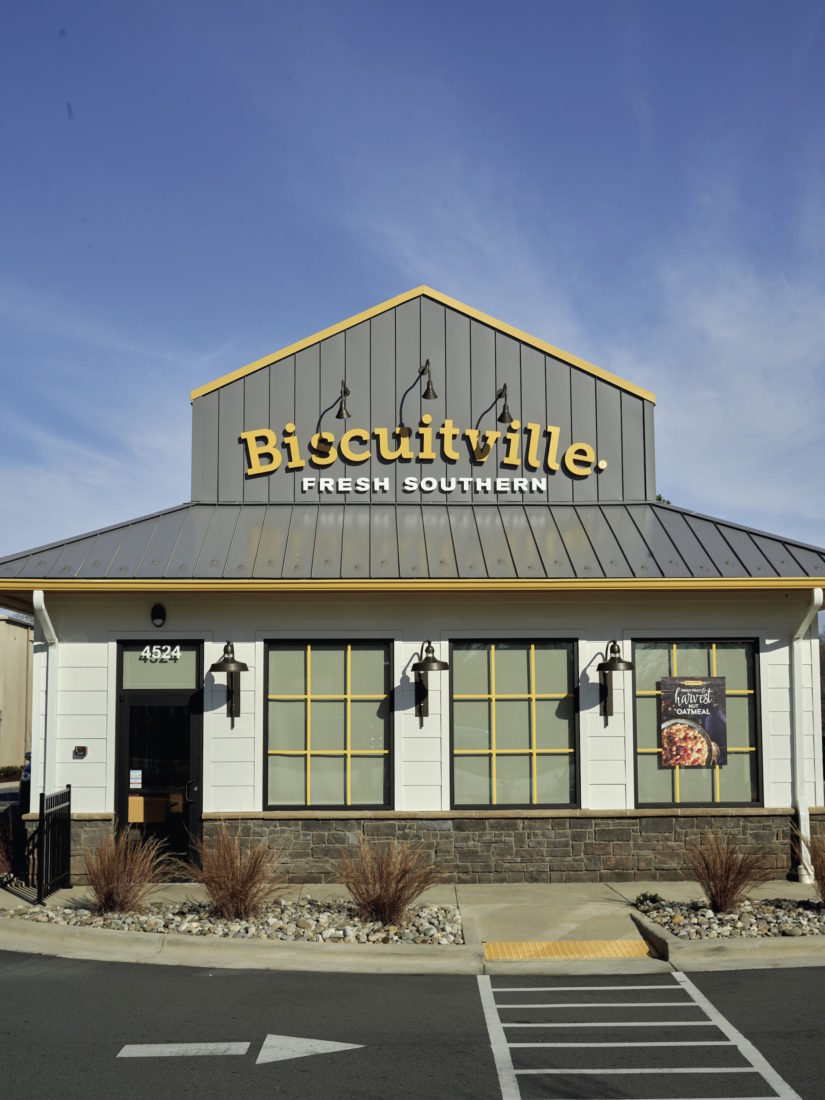Behind a glass wall printed with the slogan HOME OF THE BISCUIT WINDOW, Cynthia Yow mixes flour and buttermilk and shortening in a wide bowl. She wears a white chef jacket and a white hat stitched with the tagline FRESH SOUTHERN. To her right, painted wheat stalks play across a field of corrugated tin. Next to the register, mounted on wallpaper that looks like weathered barnwood, a constellation of icons mark the local and regional sources of the ingredients that come out of this kitchen: Flour from Henderson, North Carolina. Country ham from Wilkesboro, North Carolina. Pimento cheese from Pawleys Island, South Carolina.
A rectangular tray of fifteen biscuits exits a nearby conveyor belt oven, interiors as soft as cotton bolls, tops as brown as cured tobacco. Above the stainless-steel table where Yow rolls and folds and punches dough rounds for another tray, a mirror reflects her work into a dining room decorated with slogans that read LOCALLY SOURCED, AUTHENTIC SOUTHERN, and FARM TO DRIVE-THRU.

A squat white-and-yellow building capped by a tin roof, this Biscuitville on busy West Wendover Avenue in Greensboro, North Carolina, looks like the fifty-nine other Biscuitville locations in North Carolina and Virginia. From their ovens emerge low-crowned biscuits, absent the excess shortening that soaks so many fast-food versions. Stuffed with patty sausage that tastes of sage, or that thin-cut country ham from Wilkesboro, Biscuitville biscuits, priced around three dollars a pop, taste like what happens when, instead of trying to preserve culture, Southerners embrace change to sustain culture.
Compared with barbecue and fried chicken, which claim longer histories, biscuits are the most modern food that Southerners regard as traditional. Instead of relying on yeast and time to rise, biscuits gain quick lift from baking soda or baking powder, leavening agents that came on the market in the latter half of the nineteenth century. As Southerners moved from farms to cities in the middle years of the twentieth century, biscuits stuffed with sausage patties or slices of country ham, wrapped in foil or tissue, proved good for morning drives from home to work.
My family history tells part of the story: When I was a boy in Clinton, Georgia, in the sixties and seventies, my mother didn’t make biscuits. Salmon croquettes, sure. Cornbread in a bacon-greased skillet, yes. But she bought frozen biscuits by the foil tray and the pasteboard tube from the grocery store. (Pioneered by a Louisville company, grocery store biscuits have been sold across the region since the 1930s.) Though my love of biscuits was born of the freezer case, it was stoked by a nostalgia for the home baking that Southerners of my parents’ generation gave up as they moved to cities. Fast-food biscuits were the next logical step. You didn’t even have to heat the oven. By the late 1970s, when I went to high school, my father and I had begun to buy morning sausage biscuits from the Hardee’s drive-through.

Biscuitville began in that same era. Its founder, Maurice Jennings, grew a day-old-bread store in Burlington, North Carolina, into twelve locations of a restaurant he called Pizzaville, his son and Biscuitville’s CEO, Burney Jennings, tells me later that morning, over a second breakfast at a crosstown location. To earn extra money, Maurice warmed house-baked biscuits to order in a pizza oven and installed a jelly bar. He took what he learned and opened his first Biscuitville, in Danville, Virginia, in 1975. “Back when he sold pizzas, he set it up so that you could watch them work the dough,” Burney says. “When hestarted making biscuits, they worked behind biscuit windows.”
Southern culture endures when it adapts. That’s the lesson of the Delta blues, which found a new relevance and a bigger audience when it went electric in the 1940s in Chicago bars. Southern Baptist churches grew their reach in the 1970s through television. To sell the South, fast-food companies adapted, too, adding biscuits to burger and fried chicken menus. Hardee’s, my high school choice, popularized fast-food biscuits. Chick-fil-A followed in 1985, and McDonald’s a year later. Southerners packed those drive-throughs. They still do.
Across the nation, restaurant breakfast revenues are up. Large and small biscuit players have grown their businesses. Martin’s, founded as a burger joint in 1962 in Austell, Georgia, has expanded to sixteen biscuit houses across the Atlanta suburbs. Tudor’s Biscuit World, which began in 1980 in Charleston, West Virginia, now serves bologna, egg, and cheese biscuits in seventy-seven spots in four states. Cracker Barrel just bought the fast-growing Jacksonville, Florida–based Maple Street Biscuit Company and its menu of biscuits stuffed with goat cheese or smothered with shiitake gravy.
Biscuitville isn’t a franchise. The company owns and operates all of its stores (except one at Elon University, which graduated both Jennings men). But Biscuitville is growing like one. On the morning Jennings and I share a spicy chicken biscuit slathered with honey, and a cup of grits piled with cheddar, construction crews are working on three new North Carolina locations.
The company is profitable enough, Jennings says, that Biscuitville can grow by 10 percent each year going forward without taking on debt. Once regional, these restaurants may well go national. Biscuitville plans to get there by rolling and baking honest biscuits that gesture to a Southern past without hewing to that past. Getting the mix of tradition and innovation and regional identity right will prove a challenge in the years to come. Many Southern restaurants have lost their way as they have expanded. Biscuitville aims to do the hard work of carrying forward the best of the traditional South into the future-tense South. FARM TO DRIVE-THRU might be a goofy slogan, but the proof of the promise lies in those white paper wrappers, passed each morning through order windows to hungry drivers.








